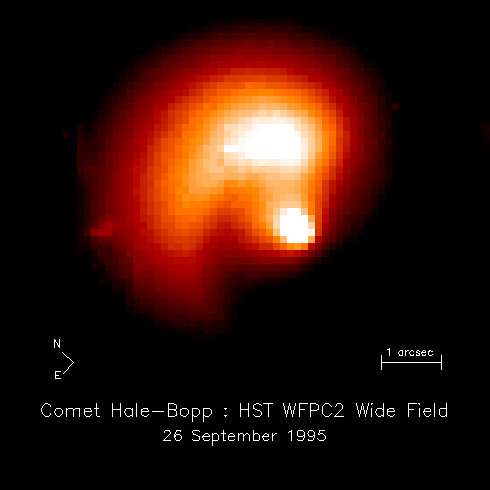Hubble Sees Material Ejected From Comet Hale-Bopp

HST Image of Comet Hale-Bopp
Observers: H. Weaver, P. Feldman
Instrument: Hubble Space Telescope
Date: September 26, 1995
These NASA Hubble Space Telescope pictures of comet Hale-Bopp show a remarkable "pinwheel" pattern and a blob of free-flying debris near the nucleus. The bright clump of light along the spiral (above the nucleus, which is near the center of the frame) may be a piece of the comet's icy crust that was ejected into space by a combination of ice evaporation and the comet's rotation, and which then disintegrated into a bright cloud of particles.
Although the "blob" is about 3.5 times fainter than the brightest portion at the nucleus, the lump appears brighter because it covers a larger area. The debris follows a spiral pattern outward because the solid nucleus is rotating like a lawn sprinkler, completing a single rotation about once per week.
Ground-based observations conducted over the past two months have documented at least two separate episodes of jet and pinwheel formation and fading. By coincidence, the first Hubble images of Hale-Bopp, taken on September 26, 1995, immediately followed one of these outbursts and allow researchers to examine it at unprecedented detail. For the first time they see a clear separation between the nucleus and some of the debris being shed. By putting together information from the Hubble images and those taken during the recent outburst using the 82 cm telescope of the Teide Observatory (Tenerife, Canary Islands, Spain), astronomers find that the debris is moving away from the nucleus at a speed (projected on the sky) of about 68 miles per hour (109 kilometers per hour).
The Hubble observations will be used to determine if Hale-Bopp is really a giant comet or rather a more moderate-sized object whose current activity is driven by outgassing from a very volatile ice which will "burn out" over the next year. Comet Hale-Bopp was discovered on July 23, 1995 by amateur astronomers Alan Hale and Thomas Bopp. Though this comet is still well outside the orbit of Jupiter (almost 600 million miles, or one billion kilometers from Earth) it looks surprisingly bright, fueling predictions that it could become the brightest comet of the century in early 1997.
Even more detailed Hubble images will be taken with the Planetary Camera in late October to follow the further evolution of the spiral, look for more outbursts, place limits on the size of the nucleus, and use spectroscopy to study the enigmatic comet's chemical composition.
Credit: H.A. Weaver (Applied Research Corp.), P.D. Feldman (The Johns Hopkins University), and NASA
